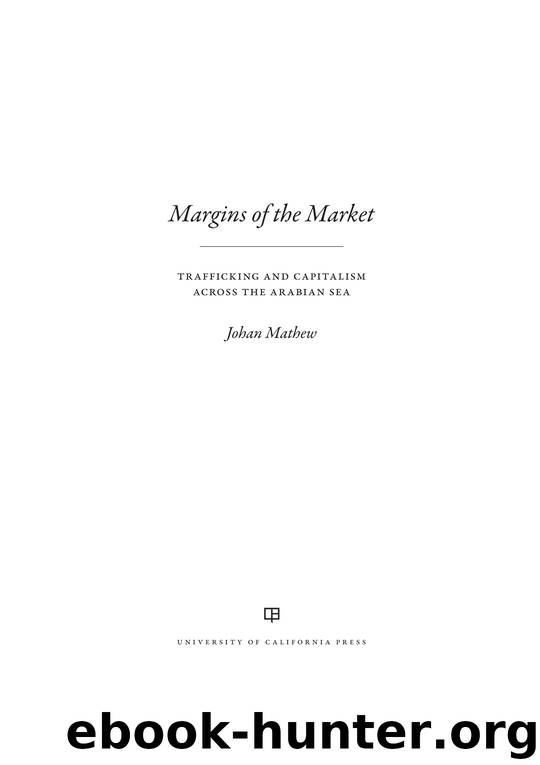Margins of the Market by Mathew Johan;

Author:Mathew, Johan;
Language: eng
Format: epub
Publisher: University of California Press
MAP 3. Major currency and specie flows. Map by author.
CONCEALING COUNTERFEITS, SMUGGLING SILVER
Apparently, Ganga Ram was not a seasoned criminal. We can imagine him being interrogated in the Karachi customs office and quickly caving under pressure. He divulged the names of four accomplices who together intended to transport about £21,000 worth of gold sovereigns. It turns out that Ganga Ram was just a small part of a substantial operation managed by a bania firm called Dhamanmal Isardas. The firm had arranged the operation so that they were buffered from the actual smugglers like Ganga Ram.44 While remaining in the safety of their family home, the firm could arrange vast traffics of coins, currency notes, promissory notes, and bills of exchange. It was precisely their ability to obscure these forms of money that produced the largest profits. By operating beyond the perception of colonial authorities, firms were able to obtain contraband and circulate counterfeits. Customs officers were constantly working to ensure the visibility of monetary flows, while smugglers were equally working to obscure the vision of colonial officials.
At the most basic level, the illicit circulation of currency was exemplified by a group known as the Chapparband tribe. The colonial police produced a fascinating ethnography of these Muslim peasants from the district of Bijapur in central India. The men cultivated their fields and raised chickens while the women knitted quilts. When a favorable omen was obtained, the men of a village would assume the guise of wandering mendicants or fakirs and would journey on foot to the nearby princely state of Hyderabad. They coined rupees by a simple process of baking a mold out of lime and mud, melting down tin from the local bazaar, and pouring it inside the mold. This minting would occur in the evenings as the troupe camped by the side of the road. As they walked down dusty roads and through village markets, they would beg for alms and pass off counterfeit rupees to women and “simple people.” After journeying about the country, they returned to their villages with perhaps twenty extra rupees in their pockets and once again resumed work in the fields.45
This account must be taken with a grain of salt, based as it was on rumors and Orientalist speculation. Nonetheless, these reports had apparently been collected for over fifty years, and sheer repetition would seem to lend some weight to their description.46 Yet despite extensive surveillance of the Chapparbands, their activities were not important enough to elicit prosecution. Officials justified their inaction because these activities were on such a small scale and yielded almost no lasting trace. Whereas other counterfeiters could be identified by metal dies or specialized instruments, the Chapparbands destroyed their moulds in the process of extracting the counterfeit coins. The counterfeits that they produced were so crude that most market-goers would not trust the coins as legitimate. By targeting women and “simple people,” the Chapparbands exploited those who had the fewest options in terms of trading partners. More experienced market participants would be able to spot such counterfeits and would avoid transactions with unknown purchasers.
Download
This site does not store any files on its server. We only index and link to content provided by other sites. Please contact the content providers to delete copyright contents if any and email us, we'll remove relevant links or contents immediately.
Mindhunter: Inside the FBI's Elite Serial Crime Unit by John E. Douglas & Mark Olshaker(8699)
Wiseguy by Nicholas Pileggi(5315)
Hitman by Howie Carr(4824)
Room 212 by Kate Stewart(4732)
Secrecy World by Jake Bernstein(4388)
Killers of the Flower Moon: The Osage Murders and the Birth of the FBI by David Grann(4188)
Breaking Free by Rachel Jeffs(4010)
Papillon (English) by Henri Charrière(3902)
Killers of the Flower Moon by David Grann(3748)
Say Nothing by Patrick Radden Keefe(3725)
American Kingpin by Nick Bilton(3507)
The Secret Barrister by The Secret Barrister(3419)
Molly's Game: From Hollywood's Elite to Wall Street's Billionaire Boys Club, My High-Stakes Adventure in the World of Underground Poker by Molly Bloom(3332)
Mysteries by Colin Wilson(3248)
In Cold Blood by Truman Capote(3134)
I'll Be Gone in the Dark by Michelle McNamara(2888)
Signature in the Cell: DNA and the Evidence for Intelligent Design by Stephen C. Meyer(2875)
Rogue Trader by Leeson Nick(2824)
Bunk by Kevin Young(2808)
